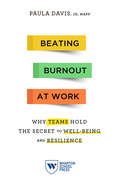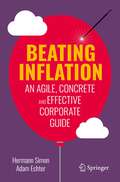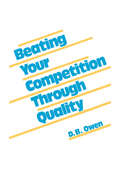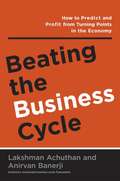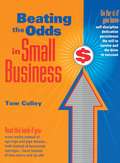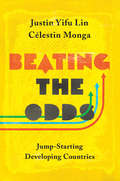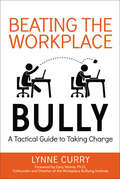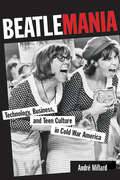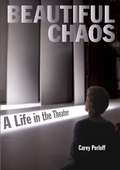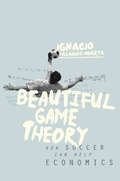- Table View
- List View
Beating Burnout at Work: Why Teams Hold the Secret to Well-Being and Resilience
by Paula DavisA first-of-its-kind, science-backed toolkit takes a holistic approach to burnout prevention by helping individuals, teams, and leaders build resilience and thrive at work.Burnout has become one of the most talked about workplace topics, and its impact is far-reaching. The 24/7 pace of work, constant demands, and scant resources can easily put busy professionals on a path to burnout, a cycle that has only accelerated during the COVID-19 pandemic. Burnout affects the health and well-being of the entire organization, yet most attempts to help focus on quick-fix strategies aimed at individuals. Something is missing.In Beating Burnout at Work: Why Teams Hold the Secret to Well-Being and Resilience, Paula Davis, founder of the Stress & Resilience Institute, provides a new framework to help organizations prevent employee burnout.Davis's research-driven, fast-reading, and actionable book is the first of its kind to explore a new solution to the burnout problem at work: a comprehensive approach focused on building the resilience of teams of all sizes. Davis argues that teams, and their leaders, are uniquely positioned to create the type of cultures that are needed to prevent burnout.In Beating Burnout at Work, Davis shares stories from her work coaching, teaching, and training leaders and teams of all sizes, and she explores:How she navigated her own burnout as a lawyer, and how that led her to study burnout and launch a business with the aim of helping organizations and their employees become more resilient; How teams and leaders can utilize simple, science-backed strategies to create cultures that promote resilience and well-being and reduce burnout; How the Mayo Clinic, one of the most renowned medical centers in the world, has developed a powerful model to reduce burnout in its organization; How organizations dealing with high-stress challenges, including the US Army, work to increase resilience in a systemic way; andHow the German company trivago is piloting a new approach to work amid COVID-19 in order to increase team connection and resilience.Solving the burnout puzzle requires a systemic approach. In Beating Burnout at Work, Davis offers an actionable method to help leaders create cultures of well-being and resilience in their organizations.
Beating Inflation: An Agile, Concrete and Effective Corporate Guide
by Hermann Simon Adam EchterIs unabated inflation the new normal? Inflation is back and here to stay. For companies, this means that the world in which they do business has fundamentally changed. This book examines inflation from multiple perspectives and offers actions and strategies for companies to cope with and manage it to ensure their survival. For businesses and consumers, it is not a question of eliminating inflation, but how to cope with it in order to suffer as little damage as possible. This includes not just price management, but also sales, finance, purchasing, cost management along with digitalization and innovation activities in equal measure. It also requires corporate cultural change, which if managed fast and successfully, the prospects of defeating inflation and thus ensuring the survival of the company are good.
Beating Low Cost Competition
by Adrian RyansLow cost competitors, who offer "good enough" products and services at very attractive prices, are currently significantly impacting the businesses of many leading companies, and some are starting to "move up" to challenge the traditional companies in their core markets. It's only a matter of time before most companies will feel the pressure from these aggressive, cut-price competitors. Beating Low Cost Competition offers a step-by-step structured approach to help executives in traditional companies with premium brands think through the options for responding to their low cost rivals and select the most appropriate strategy to win in their chosen markets. By examining a wide-ranging group of companies from around the world, Adrian Ryans provides numerous examples of how different companies in different industries have responded to low cost competitors and analyses the effectiveness of their strategies. He also discusses the leadership and cultural challenges that many companies are facing as they take steps to respond to their low cost rivals. Ultimately, the insights gained from this book will lead to better and more profitable business decisions. Adrian Ryans is Professor of Marketing and Strategy at IMD, Lausanne, Switzerland. He has designed and taught on executive programs for organizations in North America, Europe, Australia and Asia, including GE, Bank of Montreal, Medtronic, Deloitte, Borealis, Saurer, Vestas, IBM, Boeing, National Semiconductor, BioWare, ASML, Holcim, Varian, Hoechst, Amgen, Fluke, LSI Logic, Hutchison Port Holdings and Qualcomm. He has also acted as a consultant for a number of leading global corporations.
Beating Your Competition Through Quality
by D. B. OwenThis book describes how superior quality is attained and gives some of the basic techniques involved. It gives clear insight into the impact of variation on the future of the World and addresses the statistical problems.
Beating the Business Cycle
by Lakshman Achuthan Anirvan BanerjiHow can you make wise decisions about your company and your personal future when you have no idea where the economy is headed? The answer is, you can’t. But you can learn how to accurately predict turns in the economy so that you can see the road ahead. And BEATING THE BUSINESS CYCLE shows you how. In BEATING THE BUSINESS CYCLE, Lakshman Achuthan and Anirvan Banerji, the directors of the renowned Economic Cycle Research Institute (ECRI) show how anyone can predict and profit from the inevitable booms and busts of the economy. Why should we believe them? Because while so many economists and financial gurus have failed to predict recessions in the past, ECRI’s forecasts are known for being uncannily accurate. The institute successfully predicted the U. S. recession of 2001 many months before the economists did; the 1990 recession and later recovery; and most recently, the weak U. S. recovery in 2002. ECRI is in constant demand by corporate America and the media. It is the “secret weapon” of companies from Disney to DuPont, the major fund managers, and many central banks. BEATING THE BUSINESS CYCLE is the first book to reveal how decision makers at all levels–managers, small business owners, and individuals–can see into the economy’s future when making key decisions. Should a large company search out new clients and build new factories or stores, or should it consider cost cutting and layoffs? Is it the right time for you to splurge on that luxury vacation or addition to your house, or would it be more prudent to cut back on big expenditures and save money for a rainy day? Written in an easy-to-understand, accessible style, BEATING THE BUSINESS CYCLE reveals which of the hundreds of economic indicators to trust and which ones to trash. It will give you the tools and confidence you need to make the right decisions at the right times–even when the rest of the investing and business world would persuade you otherwise. Whether you are a corporate manager or the owner of a small business, whether you have your money invested in stocks or in your home, BEATING THE BUSINESS CYCLE will give you the edge you need to trump the competition and stay ahead of the crowd.
Beating the College Debt Trap: Getting a Degree Without Going Broke
by Alex ChediakBeating the College Debt Trap presents students with a better way to do college. The radically counter-cultural truth is that students don&’t have to be totally dependent on Mom, Dad, or Uncle Sam to get the most out of college. Graduation on a solid financial foundation is possible. But it will require intentionality, creativity, hard work, and a willingness to delay gratification.Chediak gets into the nitty-gritty of how to get work and make money during the college years, pay off any loans quickly, spend less, save more, and stay out of debt for good. He also unpacks how to transition from college into career, honor God while achieving financial independence, and use your finances to make a positive, eternally-significant difference in the lives of others.As a young engineering professor with an aptitude for finances and money management, Chediak has become particularly concerned with the financial health of young adults, especially in light of the ever increasing costs of college. In Beating the College Debt Trap he helps do something about this problem. He engages, in a friendly manner, the &“real world&” financial issues that 17-25 year olds face, with clarity, practical help, lots of illustrations, and a little humor, while conveying a distinctly Christian perspective.
Beating the Commodity Magnet
by V. Kasturi Rangan George BowmanAll markets follow a cycle of growth and maturity, then commoditization and decline. This note argues that while commoditization of an industry may seem inevitable, the better managed firms find a way to make money in the commodity cycle. These firms know how and when to differentiate their products through innovation, service, and customer partnerships; and how and when to offer a "no-frills" product, and seek cost leadership. Four such strategic options are detailed and discussed. A rewritten version of an earlier note.
Beating the Commodity Trap
by Richard Anthony D'AveniCommoditization-a virulent form of hypercompetition-is destroying markets, disrupting industries, and shuttering long-successful firms. Conventional wisdom says the best way to combat commoditization is differentiation. But differentiation is difficult and expensive to implement, and keeps you ahead of the pack only temporarily.In Beating the Commodity Trap, Richard D'Aveni provides a radical new framework for fighting back. Drawing on an in-depth study of more than thirty industries, he recommends first identifying the commoditization trap you're facing:-Deterioration: Low-end firms enter with low-cost/low-benefit offerings that attract the mass market-as Zara did to high-end fashion companies.-Proliferation: Companies develop new combinations of price paired with several unique benefits that attack part of an incumbents' market-as Japanese motorcycle makers did to Harley-Davidson.-Escalation: Players offer more benefits for the same or lower price, squeezing everyone's margins-as the iPhone did in mobile devices.The author provides a tool for diagnosing your competitive position and shows how to strengthen it while also boosting your pricing power-by destroying the commoditization trap confronting you, escaping it, or turning it to your advantage.Illustrated with a wealth of examples, this concise, practical guide gives you the framework and tactics you need to battle commoditization.
Beating the Dow Completely Revised and Updated: A High-Return, Low-Risk Method for Investing in the Dow Jones Industrial Stocks with as Little as $5,000
by John Downes Michael B. O'HigginsIn 1991, Michael B. O'Higgins, one of the nation's top money managers, turned the investment world upside down with an ingenious strategy, showing how all investors--from those with only $5,000 to invest to millionaires--could beat the pros 95% of the time by putting 100% of their equity investment into the high-yield, low-risk "dog" stocks of the Dow Jones Industrial Average. His formula spawned a veritable industry, including websites, mutual funds, and $20 billion worth of investments, elevating the theory to legendary status.Reflecting on the greatest bull market of our time, this must-have investment guide has been revised and updated for a new economy. With current company and stock profiles, as well as new charts, statistics, graphs, and figures, Beating the Dow is the smart investment that you--and your portfolio--can't afford to miss.
Beating the Global Odds: Successful Decision-making in a Confused and Troubled World
by Paul A. LaudicinaThe Answer to Global Overload Contending with the 24/7 news cycle and an endless barrage of choices and information has stymied leadership and decision-making strategies among those at the top. But we all know, this is not a just a problem for the elite. The broad-based reaction to this chaotic, unmanageable assault has been to retrench, and to focus on immediate, controllable decisions. In the process, we lose sight of the horizon. More dangerous still, is the shift we’ve seen from value creation to wealth creation, where information technology 1.0 has enabled a transaction-based society in which the “deal” is more important than the value it drives or the relationships it is based on. On our current path, the odds of a better future are slim. What we need is a new value proposition. Beating the Global Odds is the answer to the dangers of too much of a good thing. There’s no going back, but there is the opportunity to set things right. In this book, Paul A. Laudicina, Managing Partner and Chairman of the Board of global consulting firm A.T. Kearney, provides a fast-paced and engaging tour of how we got to this point and what we can do about it. Drawing on examples from everything from world history and current media to anecdotes from his vast network of CEOs and the world’s most innovative thinkers, Laudicina helps bring our world of seemingly fuzzy and disconnected pixels into sharp focus. The result is a compelling case for change and call to action—not only for global leaders but also for everyone who struggles with the question of how we can inspire and seize a better future… how we can beat the global odds.
Beating the Odds in Small Business: The New Entrepreneur's Bible
by Katy Riegel Tom CulleyRead this book if you: want reality instead of ego trips and pipe dreams... truth instead of buzzwords and hype... facts instead of bum steers and rip-offs. Go for it if you have: self-discipline, dedication, persistence, the will to survive and the drive to succeed.
Beating the Odds: Eddie Brown's Investing and Life Strategies
by Eddie BrownBeating the Odds is the improbable, inspiring autobiography of financial guru Eddie C. Brown, one of the nation's top stock pickers and money managers. It details how Brown skillfully kept Brown Capital Management afloat through the dot-com bust, 9/11 and the Great Recession. Born to a 13-year-old unwed mother in the rural South, this African-American investment whiz created a Baltimore-based financial firm that amassed more than $6 Billion under management. Brown delves into the profound heartbreak and disorientation upon the death of his beloved grandmother – who was his surrogate mother -- and recounts how Brown's moonshine-running Uncle Jake subsequently became the dominant adult figure in Brown's life. His unflinchingly honest, easy-to-read memoir details how intellectual curiosity, abiding self-belief, hard work and divine providence helped Brown earn an electrical engineering degree, become an Army officer, and later a civilian IBM engineer. Readers will learn of the strife that ensued when Brown quit IBM to earn an MBA, leading to investment jobs that prepared him to start his own money management company in 1983.
Beating the Odds: Jump-Starting Developing Countries
by Justin Yifu Lin Célestin MongaHow poor countries can ignite economic growth without waiting for global action or the creation of ideal local conditionsContrary to conventional wisdom, countries that ignite a process of rapid economic growth almost always do so while lacking what experts say are the essential preconditions for development, such as good infrastructure and institutions. In Beating the Odds, two of the world's leading development economists begin with this paradox to explain what is wrong with mainstream development thinking—and to offer a practical blueprint for moving poor countries out of the low-income trap regardless of their circumstances.Justin Yifu Lin, the former chief economist of the World Bank, and Célestin Monga, the chief economist of the African Development Bank, propose a development strategy that encourages poor countries to leap directly into the global economy by building industrial parks and export-processing zones linked to global markets. Countries can leverage these zones to attract light manufacturing from more advanced economies, as East Asian countries did in the 1960s and China did in the 1980s. By attracting foreign investment and firms, poor countries can improve their trade logistics, increase the knowledge and skills of local entrepreneurs, gain the confidence of international buyers, and gradually make local firms competitive. This strategy is already being used with great success in Vietnam, Cambodia, Bangladesh, Mauritius, Ethiopia, Rwanda, and other countries. And the strategy need not be limited to traditional manufacturing but can also include agriculture, the service sector, and other activities.Beating the Odds shows how poor countries can ignite growth without waiting for global action or the creation of ideal local conditions.
Beating the Street: The Best-selling Author Of One Up On Wall Street Shows You How To Pick Winning Stocks And Mutual Funds
by Peter LynchLegendary money manager Peter Lynch explains his own strategies for investing and offers advice for how to pick stocks and mutual funds to assemble a successful investment portfolio.Develop a winning investment strategy with expert advice from the nation&’s #1 money manager. Peter Lynch&’s &“invest in what you know&” strategy has made him a household name with investors both big and small. An important key to investing, Lynch says, is to remember that stocks are not lottery tickets. There&’s a company behind every stock and a reason companies—and their stocks—perform the way they do. In this book, Peter Lynch shows you how you can become an expert in a company and how you can build a profitable investment portfolio, based on your own experience and insights and on straightforward do-it-yourself research. In Beating the Street, Lynch for the first time explains how to devise a mutual fund strategy, shows his step-by-step strategies for picking stock, and describes how the individual investor can improve his or her investment performance to rival that of the experts. There&’s no reason the individual investor can&’t match wits with the experts, and this book will show you how.
Beating the Workplace Bully: A Tactical Guide to Taking Charge
by Lynne CurryWhether you&’re the target of manipulation, intimidation, verbal abuse, or deliberate humiliation, Beating the Workplace Bully will show you how to fight back.Bullies aren&’t just limited to the playground. Now they roam around from the boardroom to the break room looking to manipulate, intimidate, and humiliate--and eventually ruin your career! This book is your ammunition for fighting back.Whether the bully is a boss or a coworker, this empowering guide will help you recognize what has been causing you to become a victim, then reveals how to:Avoid typical bully trapsRemain aware and in chargeMove past your fearCalm yourself in any confrontationKeep your dignity intacHandle sneak attacksCombat cyberbullyingComplete with exercises, assessments, and real-life examples, Beating the Workplace Bully will help you reclaim your power and defeat the office bully once and for all!
Beatlemania: Technology, Business, and Teen Culture in Cold War America (Johns Hopkins Introductory Studies In The History Of Science)
by André MillardThis look at how changes in the music industry made the Fab Four phenomenon possible “presents a different interpretation of a much-studied topic” (Essays in Economic and Business History).In this unique study, André Millard argues that, despite the Beatles’ indisputable skill, they would not have attained the same global recognition or been as influential without the convergence of significant developments in the way music was produced, recorded, sold, and consumed. As the Second Industrial Revolution hit full swing and baby boomers came of age, the reel-to-reel recorder and other technological advances sped the evolution of the music business. Musicians, recording studios and record labels, and music fans used and interacted with music-making and -playing technology in new ways. Higher quality machines made listening to records and the radio an experience that one could easily share with others, even if they weren’t in the same physical space. At the same time, an increase in cross-Atlantic commerce—especially of entertainment products—led to a freer exchange of ideas and styles of expression, notably among the middle and lower classes in the U.S. and the UK. At that point, Millard argues, the Beatles rode their remarkable musicianship and cultural savvy to an unprecedented bond with their fans—and spawned Beatlemania.Lively and insightful, Beatlemania offers a deeper understanding the days of the Fab Four and the band’s long-term effects on the business and culture of pop music.
Beatlemania: Technology, Business, and Teen Culture in Cold War America (Johns Hopkins Introductory Studies in the History of Technology)
by André MillardThe fame, talent, and success of the Beatles need no introduction. Nor does the world need another book exploring the band's skill and its influence on music and society in the United States, Britain, and the rest of the world. André Millard instead studies the Beatlemania phenomenon from an original perspective—the relationship among the music business, recording technologies, and teens and young adult culture of the era. Millard argues that, despite the Beatles’ indisputable skill, they would not have attained the global recognition and been as influential without the convergence of significant developments in the way music was produced, recorded, sold, and consumed. As the Second Industrial Revolution hit full swing and baby boomers came of age, the reel-to-reel recorder and other technological advances sped the evolution of the music business. Musicians, recording studios and record labels, and music fans used and interacted with music-making and -playing technology in new ways. Higher quality machines made listening to records and the radio an experience that one could easily share with others, even if they weren’t in the same physical space. At the same time, an increase in cross-Atlantic commerce—especially of entertainment products—led to a freer exchange of ideas and styles of expression, notably among the middle and lower classes in the U.S. and the UK. At that point, Millard argues, the Beatles rode their remarkable musicianship and cultural savvy to an unprecedented bond with their fans—and spawned Beatlemania. Refreshing and insightful, Beatlemania offers a deeper understanding the days of the Fab Four and the band’s long-term effects on the business and culture of pop music.
Beatrice Companies--1985
by David J. Collis Toby StuartDescribes the history of Beatrice Companies from its beginning as a dairy in 1891 to 1985, when the company was a $12 billion conglomerate. Focuses on the corporate strategies that Beatrice followed under each of its CEOs and concentrates on the company's strategic change in the early 1980s, which was introduced by James Dutt.
Beauregard Textile Co.
by Francis J. AguilarThe sales manager and controller have to decide on a price for a textile that lost significant market share as a result of a recent price increase. Information on manufacturing costs and on the pricing behavior of Beauregard and its only competitor are available for analysis. The case provides an opportunity to practice contribution analysis, considering fixed and variable costs as reported in a typical cost report. Also tests the students' ability to recognize the need to consider the situation from the competitor's point of view. Finally, it poses a prisoner's dilemma for the two firms where each would prefer a set of prices unfavorable to the other so that prices are likely either to be unstable or to be stable at a suboptimal level for both parties. The class can close with students attempting to devise a pricing strategy that would reach the optimal level.
Beautiful Chaos
by Carey Perloff"Beautiful Chaos is an extraordinary journey of Carey Perloff and her theatre, ACT. Their continued evolution and ability to define and re-define themselves with courage, tenacity, and bravery allow them to confront what seem like insurmountable odds. This continues to shape and inspire Carey and those who work with her."--Olympia Dukakis, Academy Award-winning actress"Carey Perloff's lively, outspoken memoir of adventures in running and directing theatre will be a key document in the story of playmaking in America."--Tom Stoppard, Playwright"Carey Perloff, quite literally, raised a vibrant new theater from the rubble of an old one. This refreshingly honest account of her triumphs and misfires over the past two decades is both a fascinating read and an invaluable handbook for anyone attempting such a labor of love."--Armistead Maupin, author of Tales of the City"Carey Perloff's marvel of a book is part memoir of a working mother, a passionate artist, a woman flourishing in a male-dominated craft- and part lavish love letter to theater. It is as lively, thoughtful, and insightful an account I have ever read about the art form. This one is for any person who has ever sat in the dark and been spellbound by the transformative power of theater."--Khaled Hosseini, author of The Kite Runner"Carey Perloff is a veteran of the regional theatre wars. Beautiful Chaos is her vivacious account of her ambitious work commanding San Francisco's American Conservatory Theatre (ACT). The book exudes Perloff's trademark brio: smart, outspoken, full of fun and ferment."--John Lahr, author of Tennessee Williams: Mad Pilgrimage of the Flesh"This is an engaged, engaging, deeply intelligent, and passionate account of why the theatre matters and how it works in a city and in a society. It is also a fascinating and essential chapter in the history of San Francisco itself, as well as the story of a committed theatre artist's determination and vision."--Colm Toibin, author of Nora WebsterCarey Perloff, Artistic Director of San Francisco's legendary American Conservatory Theater, pens a lively and revealing memoir of her twenty-plus years at the helm and delivers a provocative and impassioned manifesto for the role of live theater in today's technology-infused world.Perloff's personal and professional journey-her life as a woman in a male-dominated profession, as a wife and mother, a playwright, director, producer, arts advocate, and citizen in a city erupting with enormous change-is a compelling, entertaining story for anyone interested in how theater gets made. She offers a behind-the-scenes perspective, including her intimate working experiences with well-known actors, directors, and writers, including Tom Stoppard, Harold Pinter, Robert Wilson, David Strathairn, and Olympia Dukakis.Whether reminiscing about her turbulent first years as a young woman taking over an insolvent theater in crisis and transforming it into a thriving, world-class performance space, or ruminating on the potential for its future, Perloff takes on critical questions about arts education, cultural literacy, gender disparity, leadership, and power.Carey Perloff is an award-winning playwright, theater director, and the artistic director of the American Conservatory Theater of San Francisco since 1992.
Beautiful Data: The Stories Behind Elegant Data Solutions
by Toby Segaran Jeff HammerbacherIn this insightful book, you'll learn from the best data practitioners in the field just how wide-ranging -- and beautiful -- working with data can be. Join 39 contributors as they explain how they developed simple and elegant solutions on projects ranging from the Mars lander to a Radiohead video.With Beautiful Data, you will:Explore the opportunities and challenges involved in working with the vast number of datasets made available by the WebLearn how to visualize trends in urban crime, using maps and data mashupsDiscover the challenges of designing a data processing system that works within the constraints of space travelLearn how crowdsourcing and transparency have combined to advance the state of drug researchUnderstand how new data can automatically trigger alerts when it matches or overlaps pre-existing dataLearn about the massive infrastructure required to create, capture, and process DNA dataThat's only small sample of what you'll find in Beautiful Data. For anyone who handles data, this is a truly fascinating book. Contributors include:Nathan YauJonathan Follett and Matt HolmJ.M. HughesRaghu Ramakrishnan, Brian Cooper, and Utkarsh SrivastavaJeff HammerbacherJason Dykes and Jo WoodJeff Jonas and Lisa SokolJud ValeskiAlon Halevy and Jayant MadhavanAaron Koblin with Valdean KlumpMichal MigurskiJeff HeerCoco KrummePeter NorvigMatt Wood and Ben BlackburneJean-Claude Bradley, Rajarshi Guha, Andrew Lang, Pierre Lindenbaum, Cameron Neylon, Antony Williams, and Egon WillighagenLukas Biewald and Brendan O'ConnorHadley Wickham, Deborah Swayne, and David PooleAndrew Gelman, Jonathan P. Kastellec, and Yair GhitzaToby Segaran
Beautiful Flowers of the Maquiladora: Life Histories of Women Workers in Tijuana
by Norma Iglesias PrietoPublished originally as La flor mas bella de la maquiladora, this beautifully written book is based on interviews the author conducted with more than fifty Mexican women who work in the assembly plants along the U. S. –Mexico border. A descriptive analytic study conducted in the late 1970s, the book uses compelling testimonials to detail the struggles these women face. The experiences of women in maquiladoras are attracting increasing attention from scholars, especially in the context of ongoing Mexican migration to the country’s northern frontier and in light of the North American Free Trade Agreement (NAFTA). This book is among the earliest accounts of the physical and psychological toll exacted from the women who labor in these plants. Iglesias Prieto captures the idioms of these working women so that they emerge as dynamic individuals, young and articulate personalities, inexorably engaged in the daily struggle to change the fundamental conditions of their exploitation.
Beautiful Game Theory: How Soccer Can Help Economics
by Ignacio Palacios-HuertaThe first book to use the world's most popular sport to test economic theories and document novel human behaviorA wealth of research in recent decades has seen the economic approach to human behavior extended over many areas previously considered to belong to sociology, political science, law, and other fields. Research has also shown that economics can provide insight into many aspects of sports, including soccer. Beautiful Game Theory is the first book that uses soccer to test economic theories and document novel human behavior.In this brilliant and entertaining book, Ignacio Palacios-Huerta illuminates economics through the world's most popular sport. He offers unique and often startling insights into game theory and microeconomics, covering topics such as mixed strategies, discrimination, incentives, and human preferences. He also looks at finance, experimental economics, behavioral economics, and neuroeconomics. Soccer provides rich data sets and environments that shed light on universal economic principles in interesting and useful ways.Essential reading for students, researchers, and sports enthusiasts, Beautiful Game Theory is the first book to show what soccer can do for economics.
Beautiful Light: An Insider’s Guide to LED Lighting in Homes and Gardens
by Randall Whitehead Clifton Stanley LemonBeautiful Light by internationally acclaimed lighting designer Randall Whitehead and lighting industry expert and educator Clifton Stanley Lemon is a combination of idea book, design resource, and product guide. It explores the transition in residential lighting from incandescent light sources to LEDs, and how to apply LED lighting with great success. It begins with the fundamental characteristics of light, including color temperature, color rendering, and spectral power distribution, and how LEDs differ from older light sources. Combining innovative graphics with the enduring design principles of good lighting, the book explains how to design with light layers, light people, and balance daylight and electric light. Every room of the house, as well as exterior and garden spaces, is addressed in 33 case studies of residential lighting with LEDs, with a wide variety of lighting projects in different styles. Showcasing over 200 color photographs of dramatic interiors beautifully lit with LEDs, and clear, concise descriptions of design strategies and product specifications, Beautiful Light helps both professionals and non-professionals successfully navigate the new era of LEDs in residential lighting.
Beautiful Money: The 4-Week Total Wealth Makeover
by Leanne JacobsThis revolutionary four-week wealth plan shows you how to stop chasing money and start creating joyful, powerful, and meaningful wealth. Most of us believe that pounding our way through our days is the only way to prosperity and success. We sacrifice time with our loved ones, our weekends, our vacations, and perhaps even our sanity, in exchange for a paycheck. We put ourselves and our health at the bottom of our priority list and give everything to the great pursuit. We want to have it all, but don't find satisfaction in any of our achievements. Instead, we find ourselves sitting in our offices and big houses feeling unhappy, broke, burnt out, and unfulfilled. Beautiful Money offers another option. This book does more than show readers how to make more money, streamline personal finances, and learn how to invest and budget. The Beautiful Money program is based on the simple but powerful premise that in order to achieve true wealth, you must connect and align your inner self with clear and specific external actions. Based on Leanne Jacobs’s popular Beautiful Money course, this book shows you how to connect in a deep and meaningful way with yourself and your money. Beautiful Money takes a holistic approach to increasing net worth.From the Trade Paperback edition.
